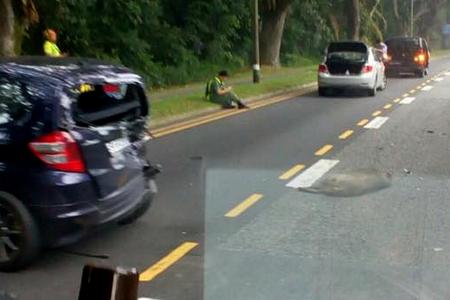Second wild boar accident in two days
In the wake of two road accidents caused by wild boars over the past two days, the Agri-Food and Veterinary Authority (AVA) said it would work with the relevant authorities to place signs in areas where animals are known to appear.
This will "help to warn motorists of potential animal encounters on the road".
The accidents happened on the Ayer Rajah Expressway (AYE) near the Tuas Checkpoint on Thursday, and along Lentor Avenue, in the direction of Yishun, yesterday.
The sudden appearance of the boar on the AYE caused an accident that sent two people on a motorcycle to hospital. The animal died.
In the Lentor case, three people, aged between 17 and 53, were taken to Khoo Teck Puat Hospital conscious. In a photo sent by reader Jason Soon, a car with a badly damaged rear was sideways in the leftmost lane of the road. The wild boar lay motionless beside it.
Responding to media queries, the AVA said wild boars are often sighted near or around forested areas, and it had "received feedback" about areas such as Tuas West, Punggol and Lorong Halus.
Explaining why wildlife, including civet cats, pangolins and wild boars, might emerge on roads, Mr Sivasothi N, a senior lecturer at the National University of Singapore's department of biological sciences, said these foraging animals move between forests looking for new feeding opportunities.
He believes that apart from putting up signs, a holistic approach to installing safety features at vulnerable areas on Singapore's roads would be helpful. He said fences could be installed on some highways adjacent to large forests. These can be designed to prevent wildlife from crossing into dangerous areas and redirect them back to nature areas.
Meanwhile, "traffic calming measures" such as the addition of speed bumps to slow down vehicles should be implemented on smaller roads adjacent to green spaces. "As we green up more of Singapore, these mitigation measures need to be set in place," he said.
Based on the National Parks Board's observations and research, there are an estimated 500 wild boars in Singapore.
These animals are native to Singapore. A female can start reproducing at 18 months of age and produce four to six piglets a year. Their quick reproduction rates, presence of ideal foraging habitats and lack of natural predators contribute to their population growth.
Environmental consultant Ong Say Lin believes in effective, long-term, natural measures such as the removal of food sources from areas adjacent to nature areas. "This may help discourage animals from venturing beyond forested habitats," he said. Wild boars are omnivorous, but they feed mainly on seeds, tubers, young plants and small insects.
A traffic advisory issued by the Traffic Police said motorists are advised to give their full attention, travel within the speed limits, stay alert to their surroundings and to keep a safe distance between their vehicle and the vehicle in front.
Singapore Safety Driving Centre's training manager Gerard Pereira believes that caution signs will help, noting that while wild boar accidents are not as common, the danger lies in how "strapping" and heavy the animal is compared to other stray wildlife.
He said: "Like how it is in other countries - cows appearing on roads in Malaysia and kangaroos in Australia - caution signs warning motorists about vulnerable areas could help alert them so that they will be more cautious.
"It is worrying for motorists, especially if you are driving at a normal speed. If you try to avoid the animal, you will probably be hit by another vehicle or drive off the road. Smaller vehicles, especially light motorcycles, are also likely to fly upon impact."
Get The New Paper on your phone with the free TNP app. Download from the Apple App Store or Google Play Store now


